| ID |
Date |
Author |
Group |
Subject |
|
223
|
07 Dec 2024, 02:04 |
Jörg Hallmann | MID | Shift summary |
data collection of bubbles in elastomers (good progress)
issue: beam loss in the tunnel during the day - experts checked the situation and the situation improved during the evening |
|
224
|
08 Dec 2024, 02:49 |
Jörg Hallmann | MID | Shift summary |
successful measurements of elastomer, gelatine & bio samples
issue:
beam loss at about 2:45 due to communication issues with accelerator modules |
|
9
|
02 Feb 2024, 12:40 |
Konopkova Zuzana | HED | Shift summary |
beam parametes: 8.5-9 kev, 1.2 mJ, 1-2 pulses
- HED trajectory established from XRO setpoint, shape and transmission optimized
- monochromator aligned
- 5 sets of CRLs including nano-focus aligned
- ZZ yesterday morning to fix cameras, connect motors..
- DAQ rolled back to legacy version, works fine
- instrument spectrometers aligned and calibrated
- We perform some longer scans with monochromated beam imaging on wires / Siemens star
- Work on shimadzu timing
- Debugging new JNGFR_DARK_CHAR middle layer with controls - done
|
|
25
|
13 Feb 2024, 08:55 |
Konopkova Zuzana | HED | Experiment summary |
*Achievements :
- Generally rather successful with very high quality beam parameters
- We had a nearly steady 800 uJ+ HXRSS flux during the user run and ~ 4mJ SASE during the setup at HED.
- Beampointing was rather stable throughout the HXRSS operation.
- Users took several shots (>2600 FEL and FEL+ReLAX shots) on target. The beamline setup was very quick prior to that and users were able to get preliminary data to prototype parameters already a day before formal handover to them and could straight go to harvest mode on Saturday morning.
-----------------------------------
* Issues :
- Users still found large Bremsstrahlung fluxes on their background, but this is rather on our side, in conjunction with the users.
- On the last day, we had issues with JF calibrations due to the high run numbers in the proposal. DOC promptly helped out.
- Initially, we observed fluctuations in the FEL flux. BKR was very prompt to correct for this and user operation was not impacted seriously. Slow drifts in pulse energy were also observed, but again, could be compensated from time to time by them.
----------------------------------- |
|
32
|
24 Feb 2024, 11:58 |
Motoaki Nakatsutsumi | HED | Shift summary |
Shift summary 2024-02-23 07:00 - 2024-02-24 10:00
We got self-seeding at 8.5 keV very quickly after changeover from 10.5 keV operation finished at 2024-02-23 07:00.
Pulse energy ~ 600 uJ.
Progress is in general good. Most of planned tasks for the day are done.
We called BKR whether we can get a bit more energy/pulse this morning, but it appears difficult. Otherwise, having a bit more energy would be helpful to have enough signal-to-noise ratio for X-ray imaging.
Achievements:
- Insert nanofocus lens, pump IC1 sample chamber into vacuum
- Establish X-ray axis, measure source point and divergence
- Set up the CRL scheme overfilling CRL4b nanofocus (the settings used in Feb at 8.2 keV were CRL1 arm 3,5 and CRL2 arm 1)
- Bring the imaging systems to the X-ray axis
- Focus and calibrate the x-ray spectrometers
- Laser-xray timing verified on YAG
- DAMNIT setup
- Nanofocus imaging optimization (Z-scans) with Cu 25um wire and Siemens star
- Best focus was identified
- Sample alignment
|
|
34
|
25 Feb 2024, 14:47 |
Motoaki Nakatsutsumi | HED | Shift summary |
Shift summary for 2024-02-24 from 07:00 to 2024-02-25 at 14:00:
Self-seeding at 8.5 keV, with approximately 500 μJ per pulse. Following re-tuning around 10 am on the 25th, the energy per pulse increased to around 600 μJ.
The x-ray intensity and pointing stability have been excellent, resulting in a substantial amount of data being acquired by users just two days into the beamtime. Users have expressed satisfaction with the performance thus far.
There were a couple of brief beam downtimes, but they had minimal impact on beamline operations.
Achievements:
- Successful laser delay scan (0 - 1000 ps) of wire compression dynamics under ultra-intense laser interaction (>10^21 W.cm-2).
- Nanofocus Z scan imaging completed.
- Online analysis tools (DAMNIT) are functioning properly.
- Some minor issues with the automatic shot procedure using MDL were encountered but mostly resolved.
- Ongoing issues persist with the off-axis-parabola mirror X axis (motor movement not stopping), which will require follow-up after the beamtime.
- A minor issue was identified with laser timing jumps, possibly stemming from a trainID distribution issue with the ToD system. Increasing the sequence delay of the master timer from 10 to 30 appears to have mitigated this problem.
|
|
36
|
26 Feb 2024, 14:32 |
Motoaki Nakatsutsumi | HED | Shift summary |
Shift summary for 2024-02-25 from 11:00 to 2024-02-25 at 14:00:
Self-seeding at 8.5 keV, with approximately 500 μJ per pulse.
Overall, the performance of x-ray self-seeding remains good, and users are happy. Pointing stability is also exceptional. However, enhancing photon energy slightly (600 uJ as we had yesterday) would further improve the signal-to-noise ratio.
Key Achievements and Current Challenges:
- Ongoing data accumulation.
- Issue with the sample motor (stepper motor). The encoder ceases to update values although the motor is actually moving. While a temporary workaround has been implemented, a thorough investigation is needed post-beamtime. More details: [Link]
|
|
95
|
05 May 2024, 00:25 |
Konopkova Zuzana | HED | Experiment summary |
- proposal 5700 finished on 04.05. The experiment used 352 pulses at 4.5 MHz and 18 keV to X-ray heat pressurized samples in diamond anvil cells. Overall succesful on several samples.
- Issues:
- the requested 20.5 keV photon energy had too low pulse intensities so we had to go down to 18 keV
- pulse energies at 18 keV (300-400 uJ) were insufficient for some samples
- the ramp in pulse envelope has not been delivered consistently throughtout the experiment (eventually we gave up due to the average low pulse energies)
|
|
114
|
27 May 2024, 06:41 |
Konopkova Zuzana | HED | Shift summary |
beam parameters: 2 colors at around 6.5 keV, 1 pulse
achievements:
user program continues with data acquisition at slightly varying photon energies (tens of eV both colors simultaneously) and at different delays between the colors
Issues:
- users have scheduled datasets to be measured overnight with larger delays up to 350 fs, however, the BKR was able to go only up to 100 fs delay despite having larger delays earlier in the experiment (even during nights)
|
|
29
|
22 Feb 2024, 06:13 |
Peter Zalden | FXE | Shift summary |
Beam conditions:
- Used photon energies between 6 and 7 keV, including short undulator scans
- Continuously got 1 mJ despite the short pulse mode that's running
- Bandwidth was found to be 18 eV FWHM at 6.07 keV (0.3%) by monochromator scan against fixed undulator setpoint
Achievements:
- Cr foil scan for energy calibration of the FXE mono
- Prepared setpoints for XAS scans during next week's user expts. at: Ce L3 (5.72 keV), Ce L2 (6.16 keV) and Mn K (6.54 keV)
- IPM calibration against XGMD
Issues:
- ATT MDL (class JJAttenuator) got stuck in INIT state and then did not show that absorber was inserted in the beam path (ticket to be submitted to Ctrls)
- DA3 of FXE DAQ (FXE_DAQ_DATA/DA/3) got stuck in changing state (it got too many parameters inserted). The restart by shutting down the server and waiting for the device to come back up took around 20 mins, see 22.2.2024, 4:24 am to 4:43 am.
|
|
38
|
28 Feb 2024, 06:57 |
Peter Zalden | FXE | Issue |
Not sure if this is the cause of the fringes reported before, but at 5.6 keV there are clear cracks visible on the XTD2 Attenuators 75 umm and 150um CVD, see attached. There is also a little bit of damage on the 600 um CVD, but not as strong as the others.
At 5.6 keV we will need to use the thin attenuators. I will mention again in case this causes problems downstream.
Edit 8:50h: We do not observe additional interference effects in the downstream beam profile (see attachement 4) |
| Attachment 1: 2024-02-28-064435_203161010_exflqr51474.png
|
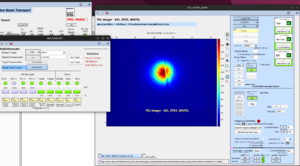
|
| Attachment 2: 2024-02-28-064443_551842636_exflqr51474.png
|
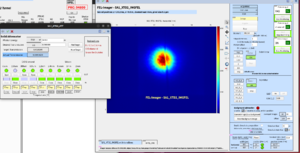
|
| Attachment 3: 2024-02-28-064454_671377179_exflqr51474.png
|
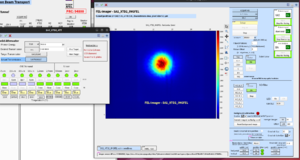
|
| Attachment 4: 2024-02-28-085524_727294913_exflqr51474.png
|
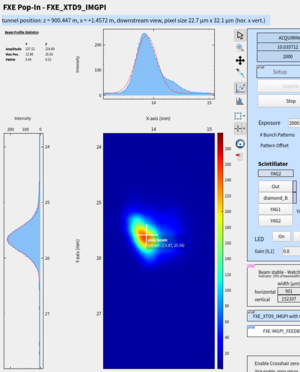
|
|
39
|
28 Feb 2024, 08:57 |
Peter Zalden | FXE | SA1 status |
5.61 keV setpoint in SA1 was confirmed to correspond to 5.660 keV (+/- 0.003 keV), see attached.
The user expt #5644 can proceed as planned. |
| Attachment 1: 2024-02-28-081608_626485769_exflqr51474.png
|

|
|
58
|
20 Mar 2024, 23:15 |
Peter Zalden | FXE | Shift summary |
Preparation for user experiment transient grating, Cris Svetina
- Used 7.12 keV from ACC with very good performance, above 4 mJ
- Got spatiotemporal overlap with transient gratings using monochromatic beam
- One issue solved by DOC: Picomotors could not be scanned in karabacon, even though this worked well two/three weeks ago
|
|
60
|
21 Mar 2024, 23:20 |
Peter Zalden | FXE | Shift summary |
User experiment transient grating, Cris Svetina. (LTP)
- Used 7.12 keV from ACC with very good performance, above 4 mJ.
- Collected pump-probe data on user sample
- Sudden timing jump of around 20 ps. Could not find out why this happened some time between 9h today and 18h.
- Needed to add camera to DAQ. Solved this on instrument side using the DAQ assistant. Great tool!
|
|
62
|
22 Mar 2024, 23:13 |
Peter Zalden | FXE | Shift summary |
User experiment transient grating, Cris Svetina. (LTP)
- Used 7.11 keV from ACC with very good performance, above 4 mJ.
- Collected pump-probe data on user sample most of the time today, only minor interruptions due to accelerator outages
- After the outage at 21h, SASE came back with 17 eV lower photon energy, so we had to re-calibrate the undulator spectrum
- FXE will operate in 24h mode for the rest of the delivery week
|
|
63
|
23 Mar 2024, 23:12 |
Peter Zalden | FXE | Shift summary |
User experiment transient grating, Cris Svetina. (LTP)
- Used 7.11 keV from ACC with very good performance, above 4 mJ.
- Collected pump-probe data on user sample most of the time today
- FXE will operate in 24h mode for the rest of the delivery week
|
|
82
|
13 Apr 2024, 23:03 |
Peter Zalden | FXE | Shift summary |
Measurements to check the impact of bunch compression on FXE mono transmission were successful. We could change the peak current between 4 and 12 kA and saw changes in bandwidth between 17 and 100 eV (at 14 keV). Results are under evaluation.
SA1 brought to safe state:
- CRLs moved out
- Mono moved out
- CVDs in XTD2 ATT inserted
- PBLM-based feedback was started and kept running to avoid beam drifting off of M3
- Hirex shutter closed
- The M1/M2 offset was decreased a bit as compared to saturday mornings' value (was very close to total reflection limit and to safely use 100 bunches, it was decreased to be on the safe side). Should not affect further measurements for XFELO on sunday.
|
|
152
|
23 Aug 2024, 08:48 |
Peter Zalden | FXE | Shift summary |
Used 9.4 keV with 94 kHz wed and thu nights. Received approx. 0.9 mJ with large fluctuations in pulse energy, however acceptable for the tasks below.
Achievements:
- X-ray optics and goniometer aligned for next user experiment 5725
- Transmission through Mono #2 recovered and calibrated to match Mono #1
- Understood uneven beam profile of FXE PI originating from the thick XTD2 ATT CVDs. Without them, the beam looks nice.
- Observed that overbending M2 gives better beam profile than underbending under the present conditions
Issues encountered:
- Major issue: M3 RY piezo actuator not working any more. This means beam feedback cannot run and beam keeps drifting off on the instrument apertures. This cannot be compensated by M2 piezo due to the small aperture of M3. The issue was reported wednesday night to PRC, XRO and FXE group and is being worked on by XRO
- One limit switch was found swapped; fixed by FXE engineers
- Some motors moved in the opposite direction as compared to previous commissioning, even though parameters were saved and restored. Not understood, but was easy to work around.
|
|
159
|
08 Sep 2024, 20:30 |
Peter Zalden | FXE | Issue |
We observe a continuous horizontal beam drift in SA1 after the M1 incident. It seems not to converge, so one can wonder where this will go....
Attached screenshot shows the M2 piezo actuator RY that keeps the beam at the same position on the M3 PBLM. These are about 130 m apart, The drift is 1V/12 hours. 0.01V corresponds to a beam motion by 35 um. So the drift velocity is 0.3 mm/hour. In the past days this had at least once lead to strong leakage around M2. But the two feedbacks in the FXE path are keeping the beam usable most of the time. |
| Attachment 1: 2024-09-08-194936_755701995_exflqr51474.png
|
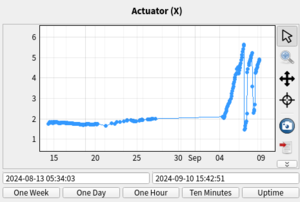
|
|
161
|
09 Sep 2024, 23:19 |
Peter Zalden | FXE | Issue |
Finally, the drift velocity of the pointing reduced approx a factor of 2 as compared to yesterday, see attached. Possibly it will still converge... |
| Attachment 1: 2024-09-09-231922_609331430_exflqr51474.png
|
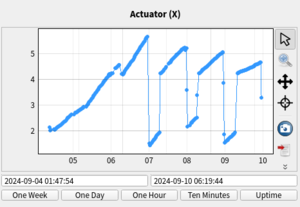
|